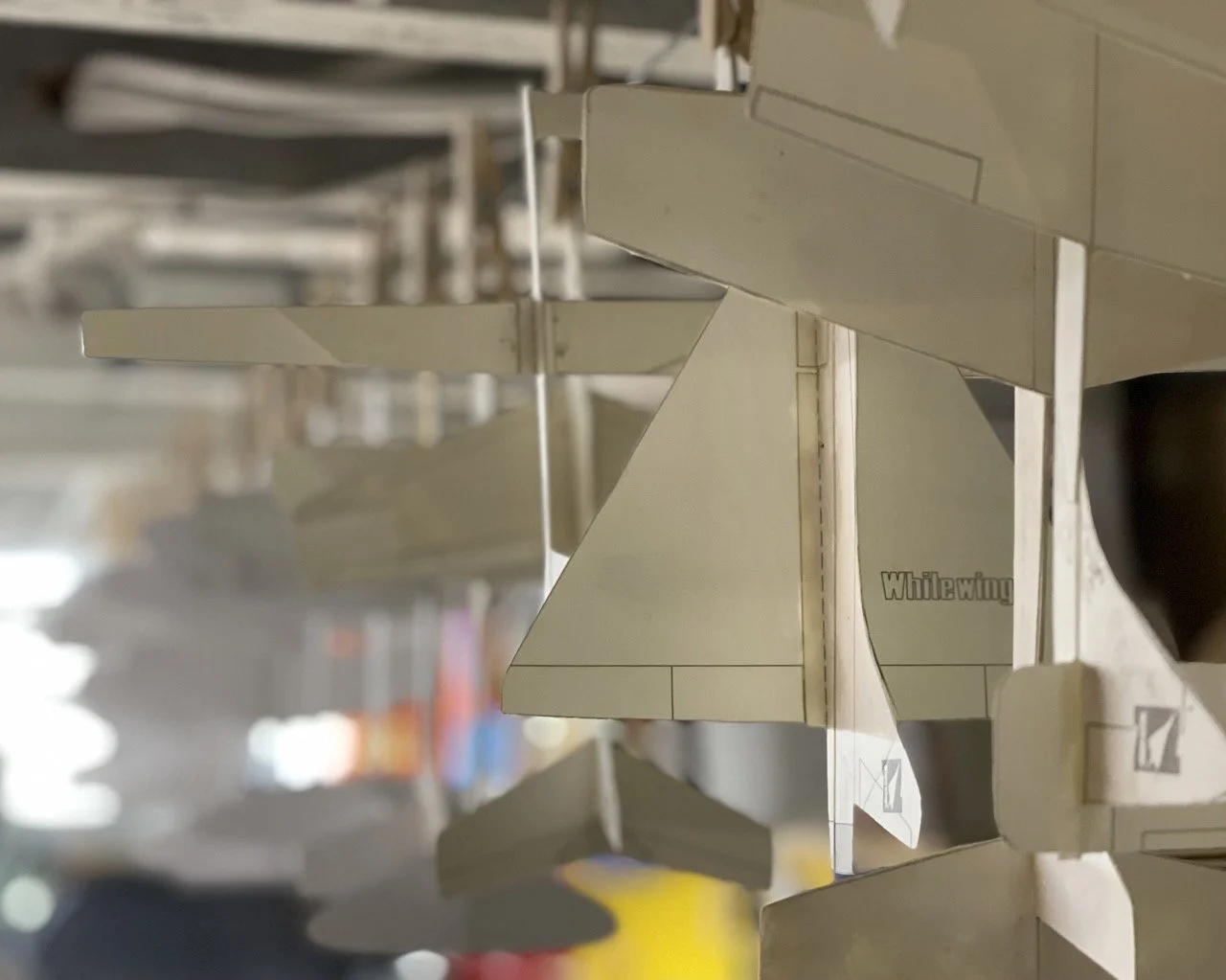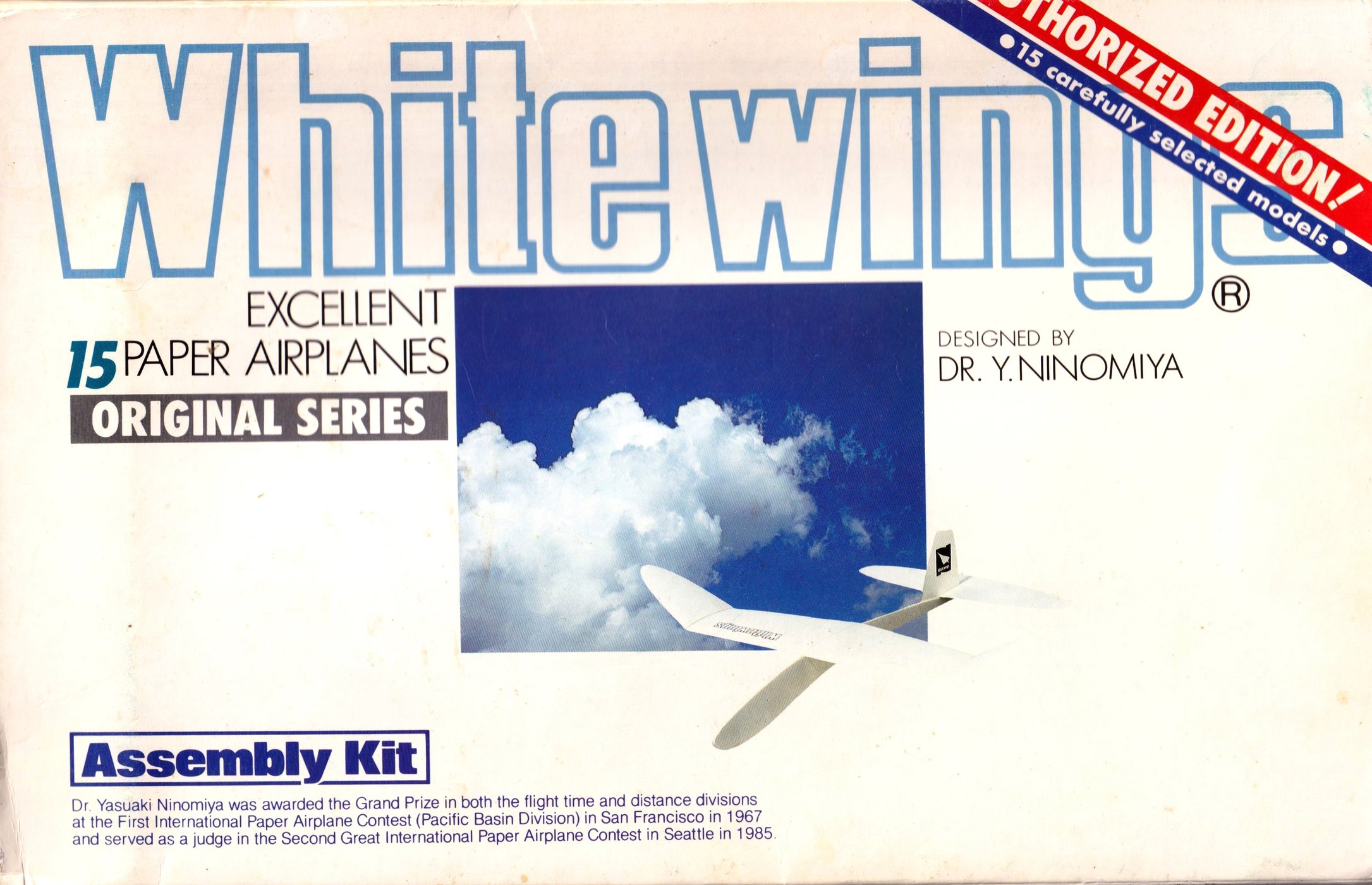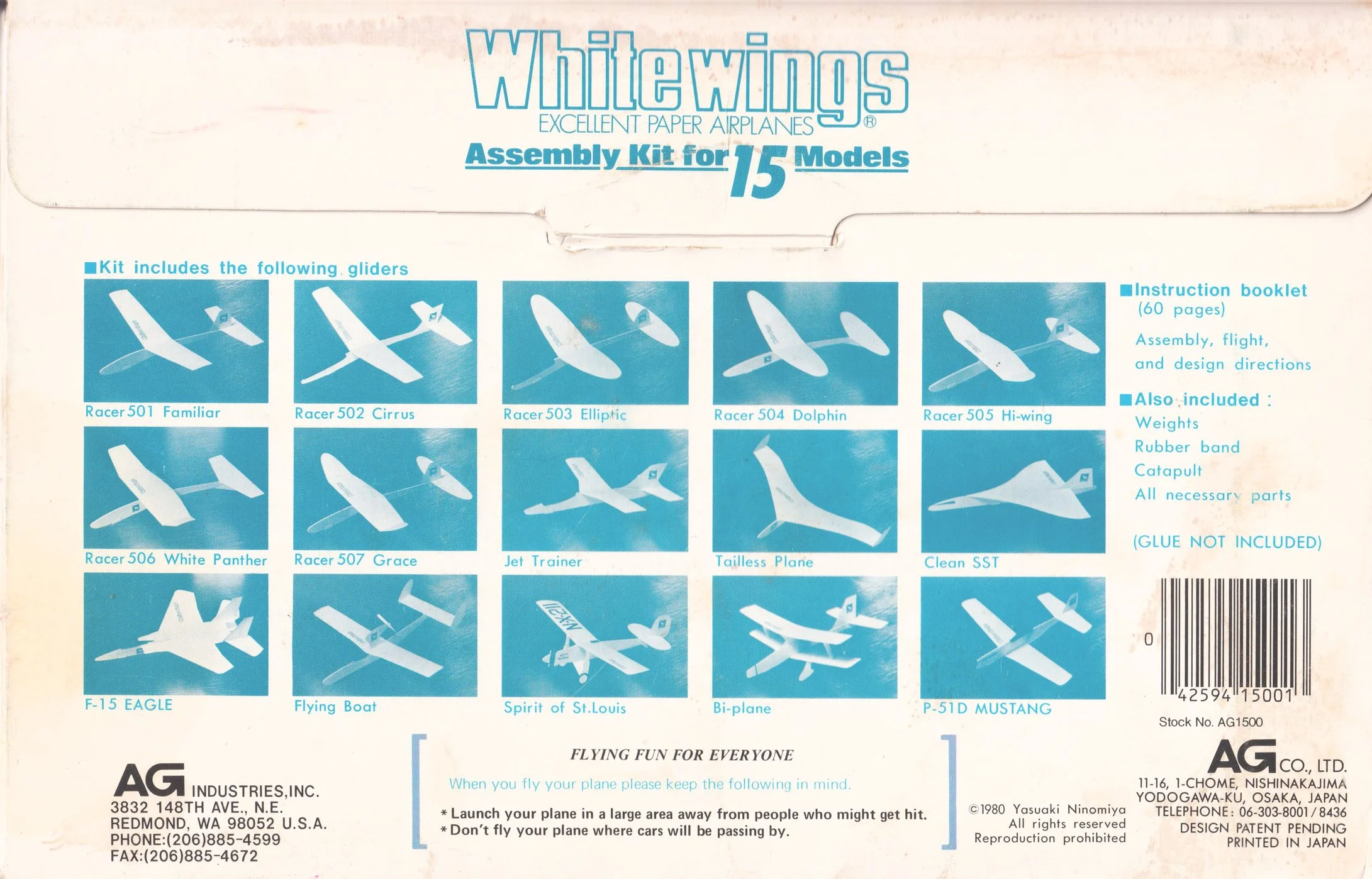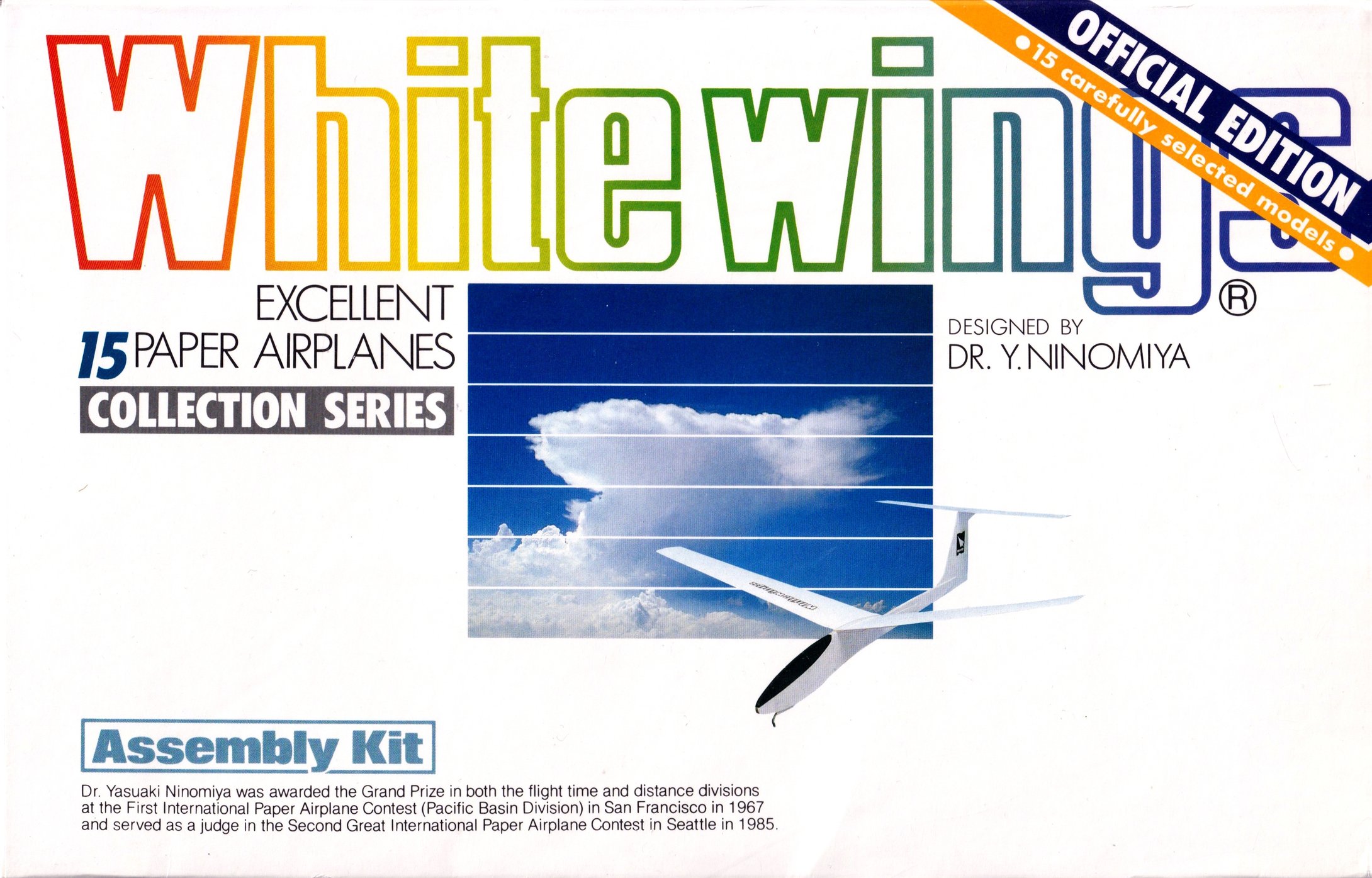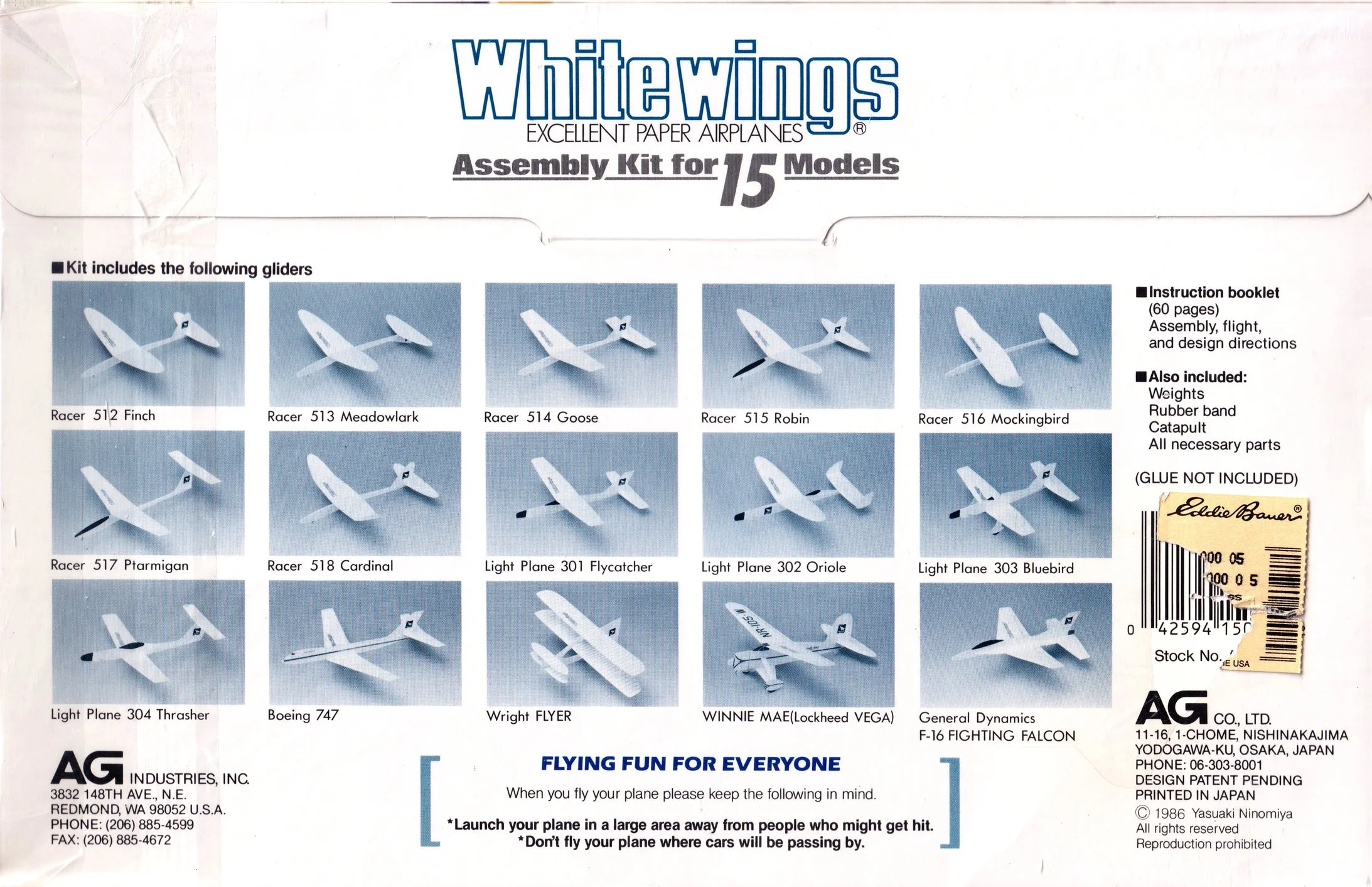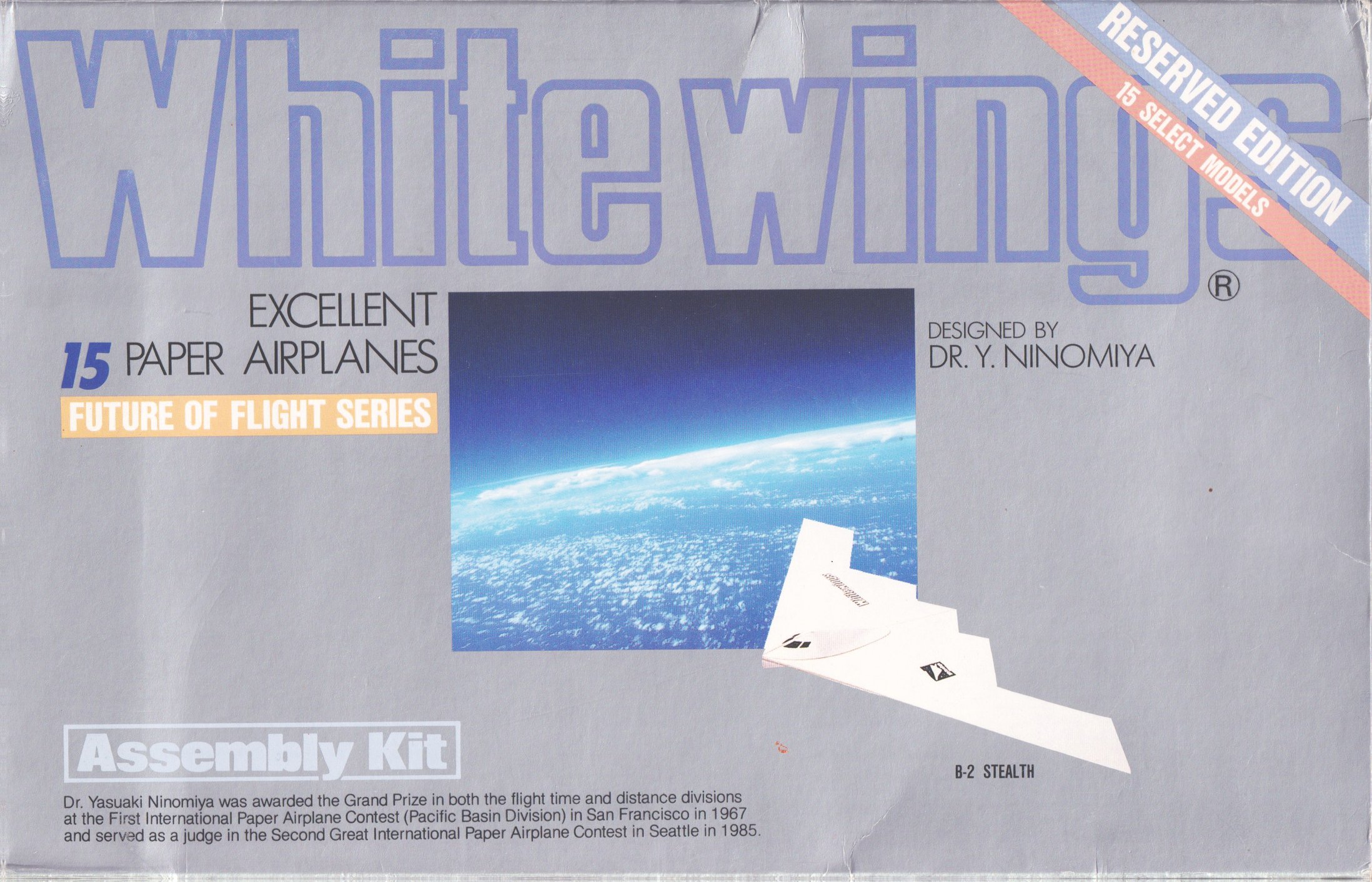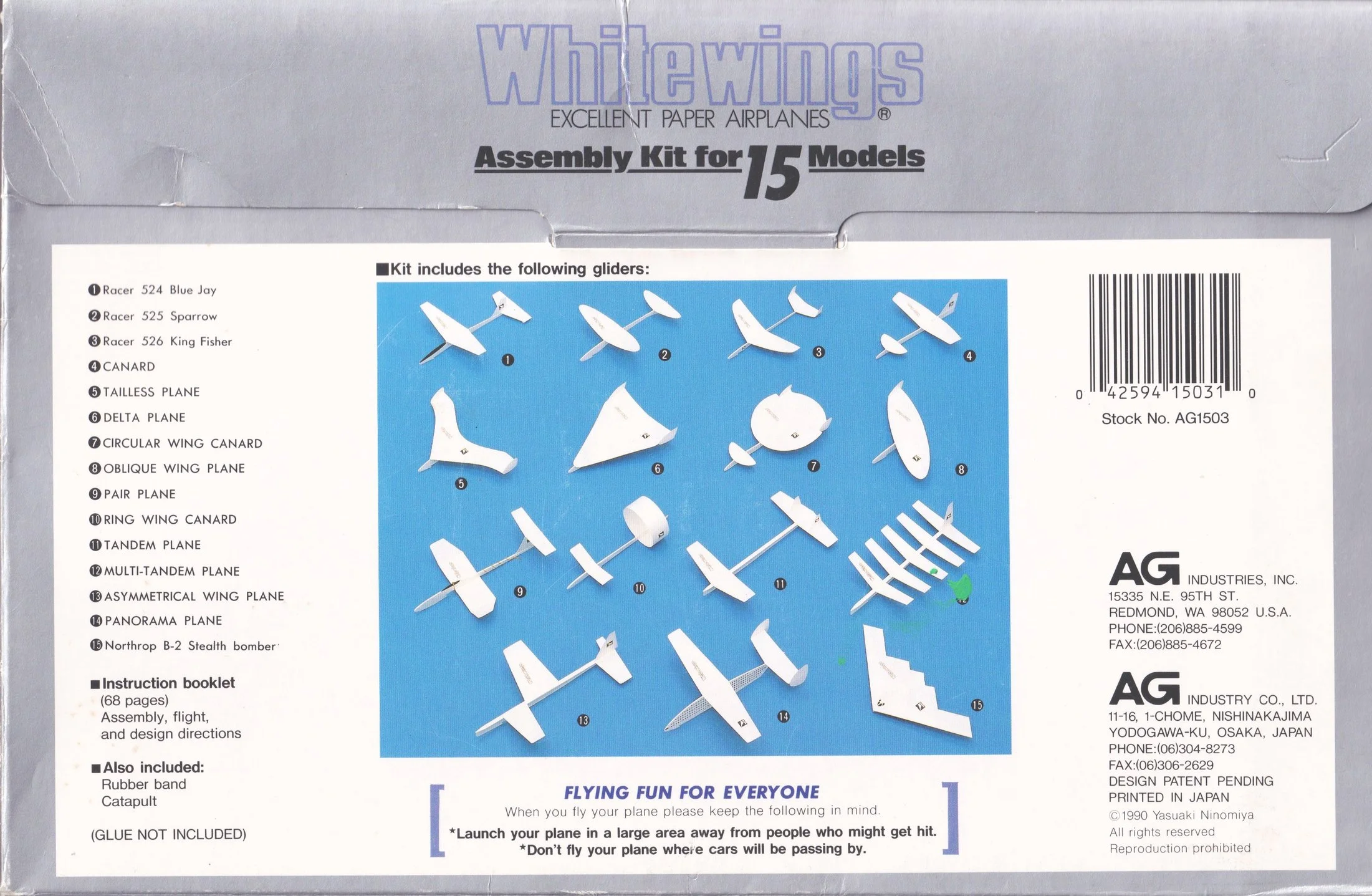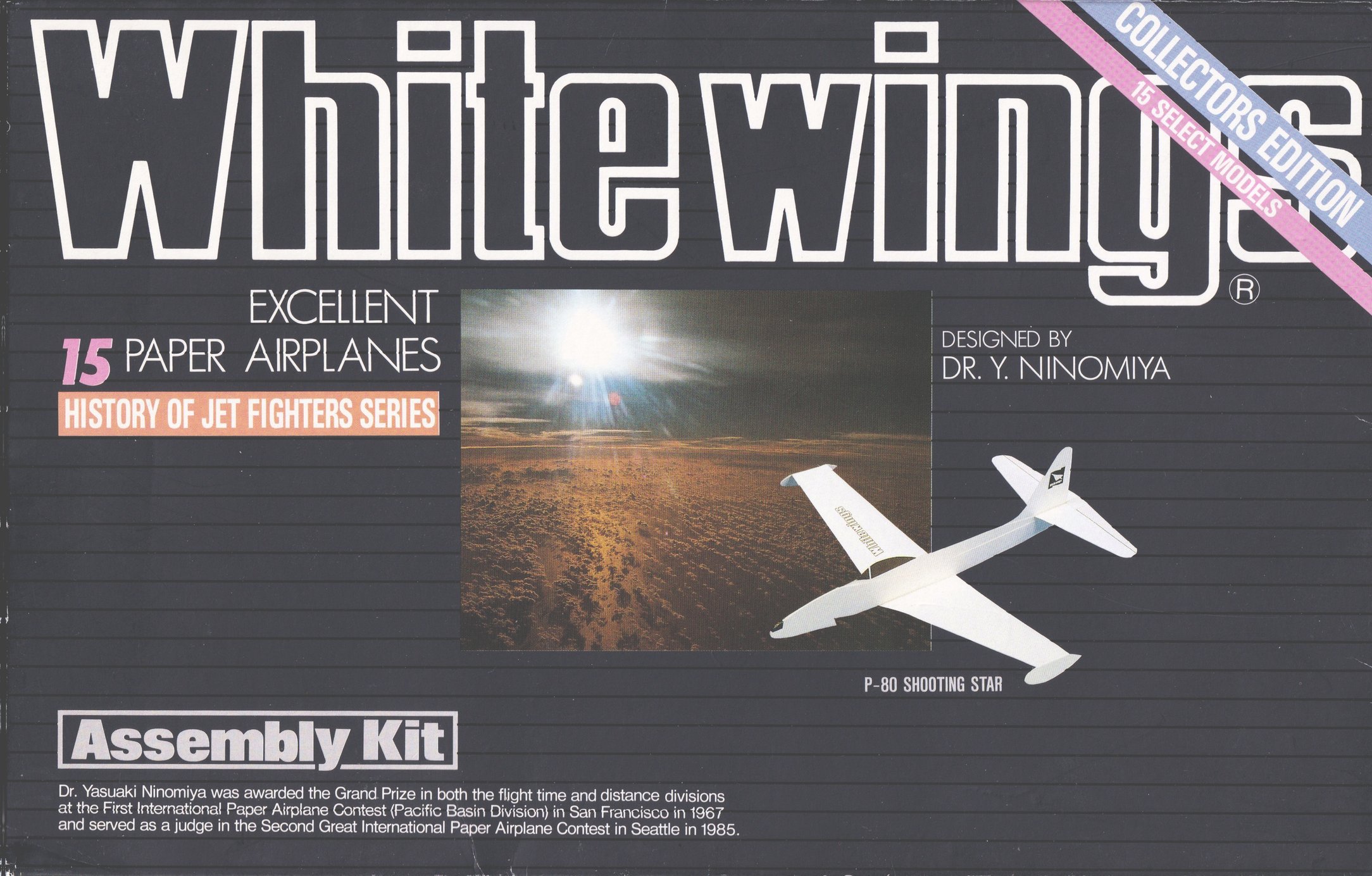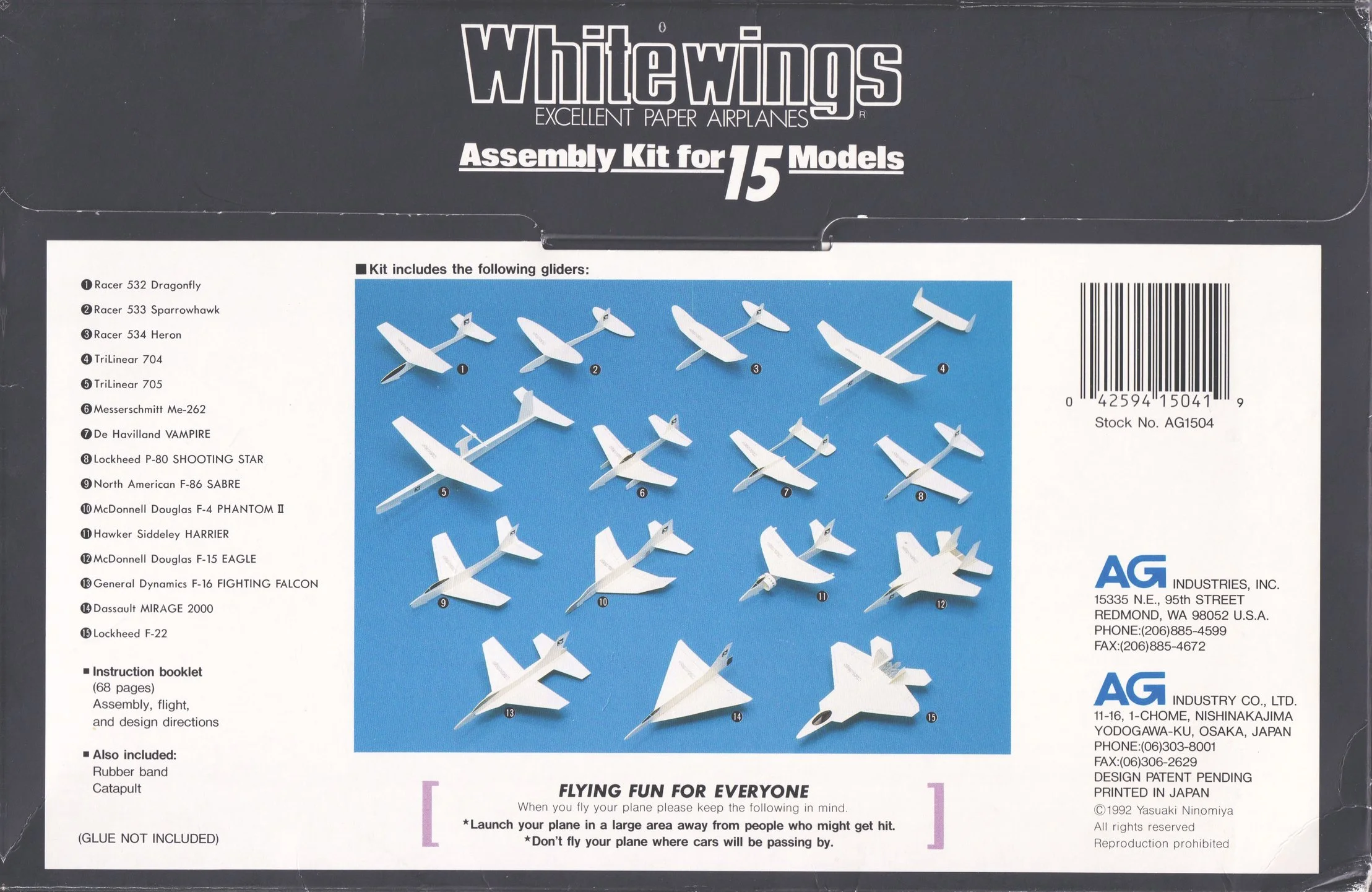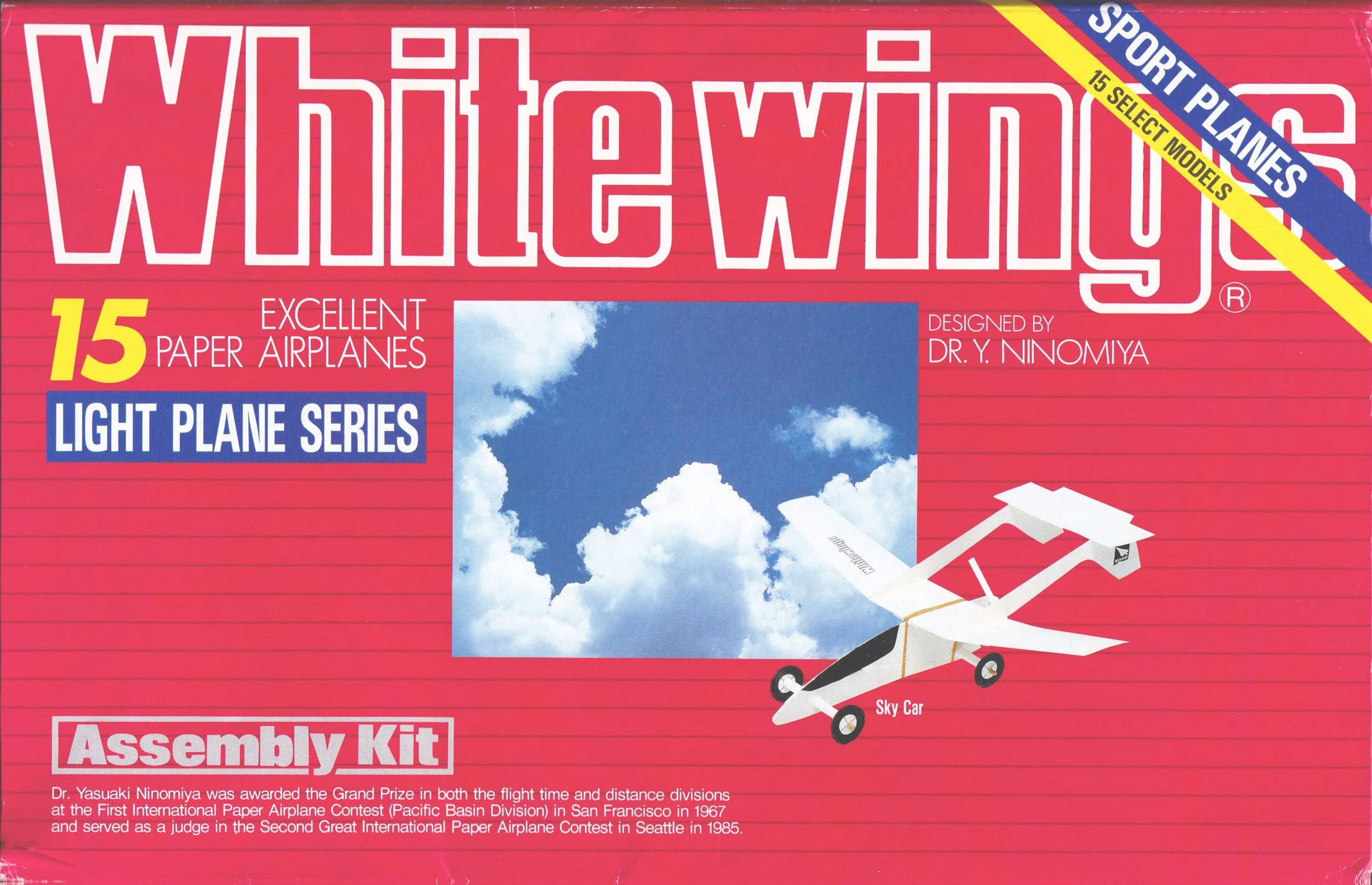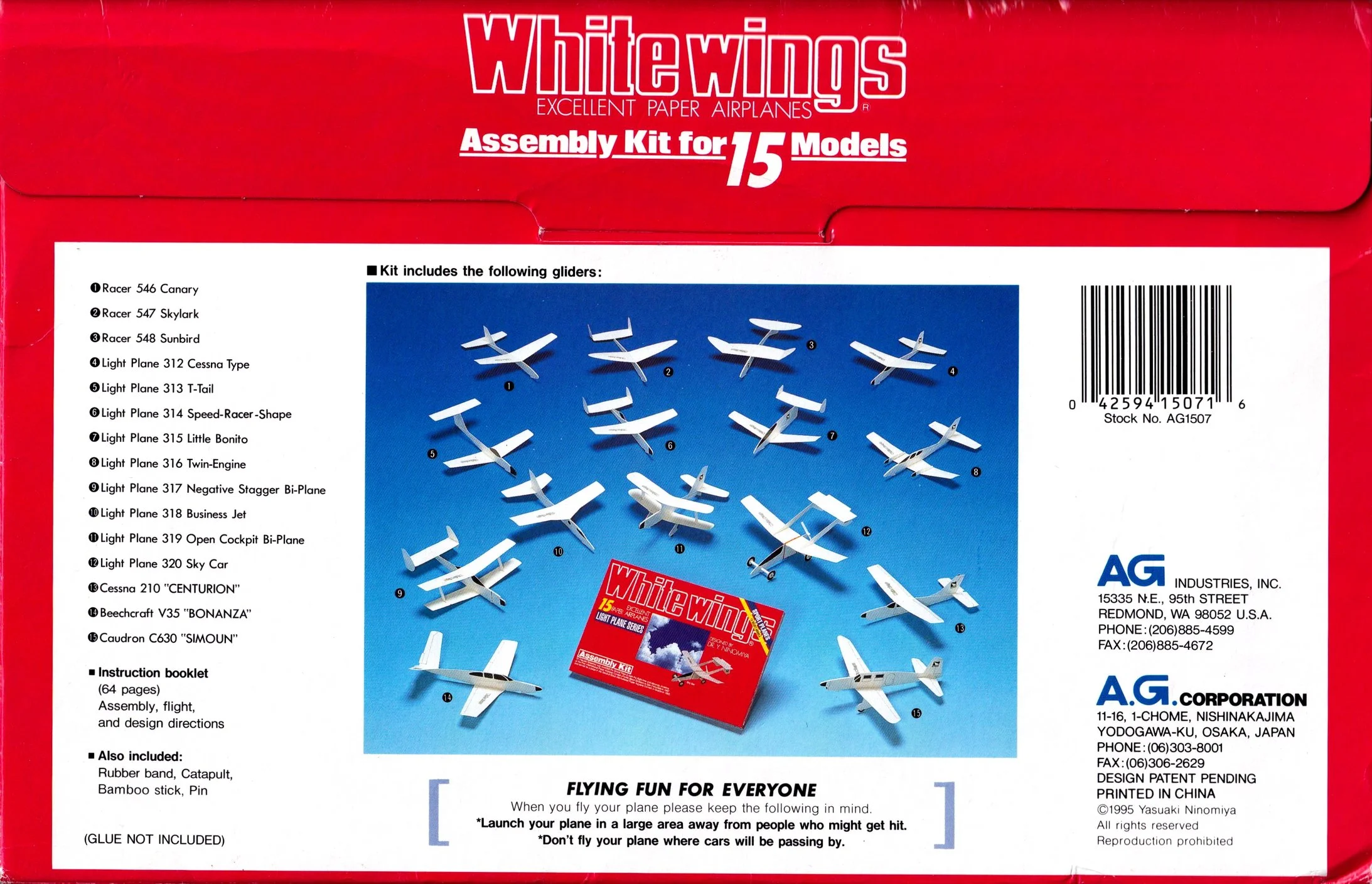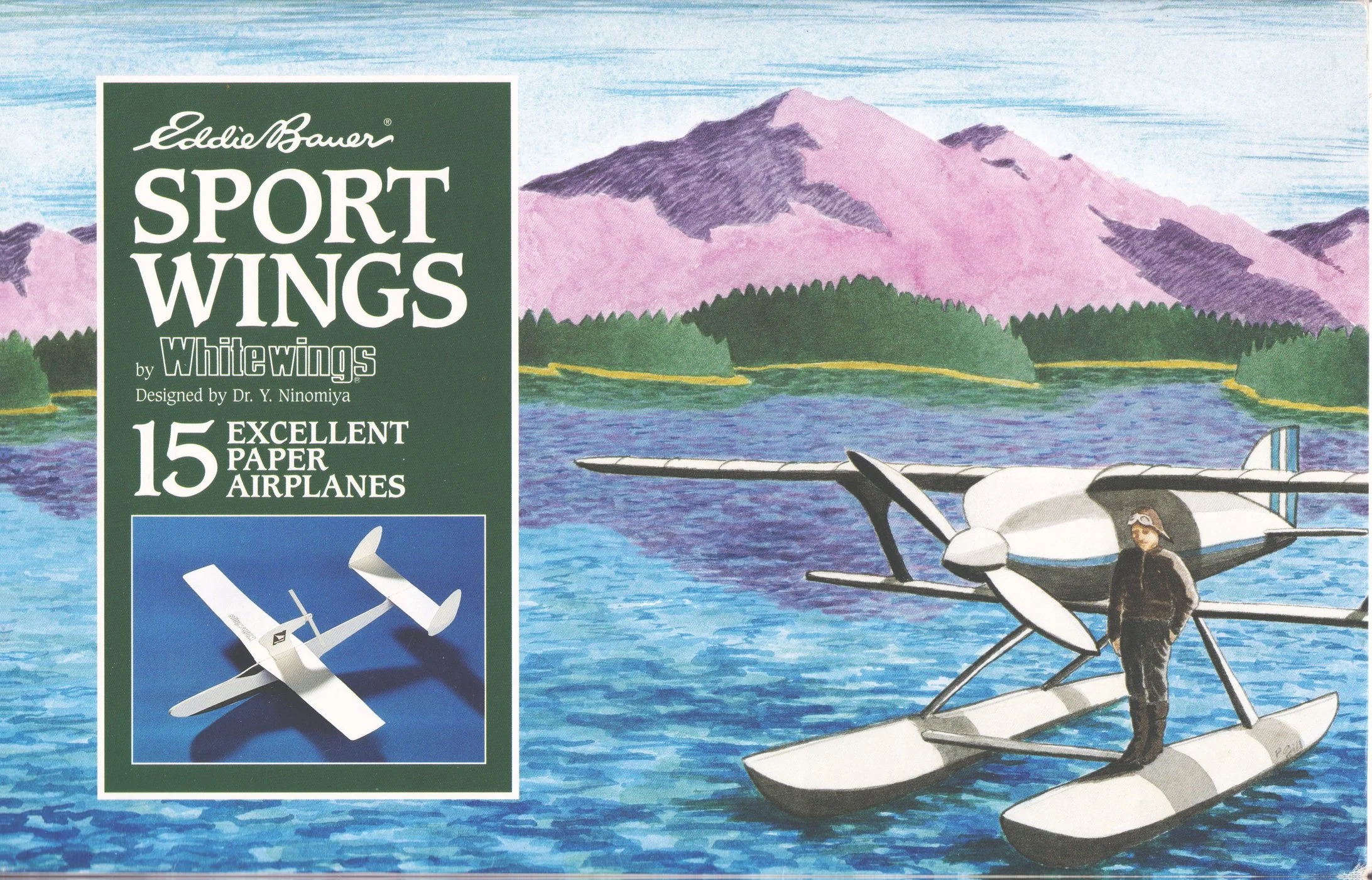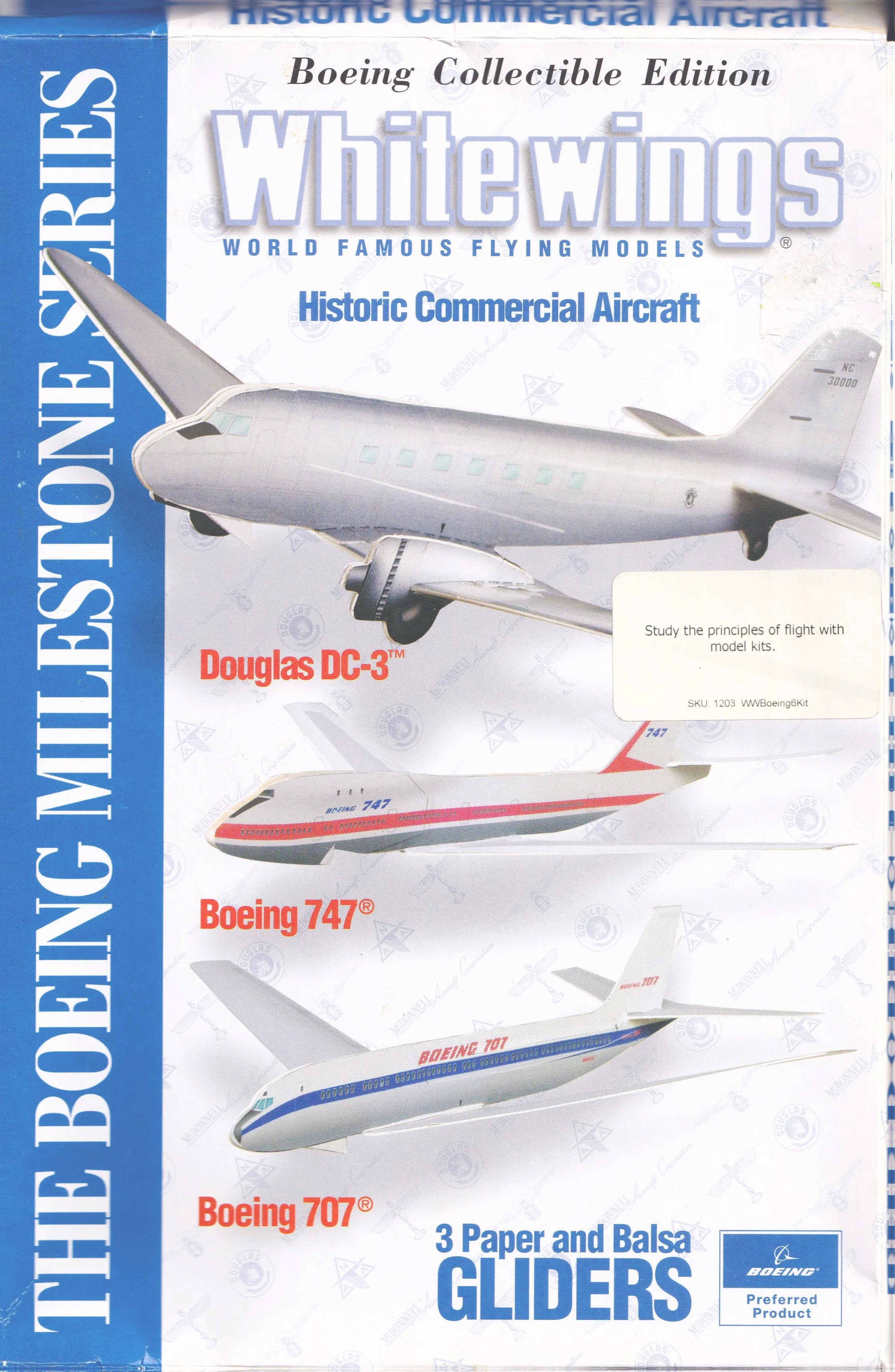An Amateur’s Guide to Collecting, Building, & Flying Whitewings Paper Airplanes
New! A store! If you like ⤵️ this guide ⤵️ and find yourself wanting to buy a pack of Whitewings, you can help me out by buying one from me. You may be able to find individual volumes for less on eBay or another site, but then you wouldn’t be subsidizing my weird hobby. What you won’t find anywhere else is the chance to buy all 8 core volumes at once.
Introduction
Dr. Yasuaki Ninomiya, an engineer from Japan, designed hundreds of paper airplanes over the course of his life. Most of his designs use layers of paper to create the models' fuselage, wings, and fins. Some replace the 6-7 layers of paper comprising the fuselage with a single piece of balsa wood.
Dr. Ninomiya's books in Japanese that describe his model airplanes' construction and contain plans for those planes have sold more than 3 million copies. He published two books in English: Jet-Age Jamboree (1968) and Airborne All-Stars (1969).
In 1980, AG Industry Co., Ltd. began distributing Dr. Ninomiya's paper airplanes in the United States under the "Whitewings" brand. As a kid, I received one of the sets sometime in the mid-to-late 80s and remember thrilling at the truly shocking performance of these simple, elegant planes. A kid in even a modestly sized town will have a difficult time finding a place open enough to fly these paper planes without risk of losing one to a tree, a roof, deep grass, or (very occasionally) the horizon itself.
Between 1980 and 1995, Dr. Ninomiya's designs were released across 8 different volumes (15 planes per series) and collected separately into three different volumes released (for some reason) by Eddie Bauer. Additionally, AG Industries released some smaller collections of balsa-based gliders, collected others for marketing to schools and museums, and individually released other models.
Each volume included not only the designs for each aircraft, but a 64-page manual that included instructions for assembling each plane and detailed sections on construction techniques, tips for flying and adjusting the planes, pages on the science of aerodynamics and aircraft design, and tips for beginners interested in designing their own planes.
This was S.T.E.A.M. before S.T.E.A.M. was cool. (Or hot. Steam, as I understand it, is normally hot.)
I suspect that other "nerds of a certain age" (that is, people born between about 1970 and 1985) will remember with fondness their own Whitewings flights many years ago. While Whitewings sets are no longer published (Whitewings.com is a sad wasteland), many sets are available on eBay and other sites for resellers (Mercari, Craigslist, etc.).
I have prepared the following guide (and accompanying spreadsheet and gallery of designs) for those nerds of a certain age looking to blow the minds of the generation of kids now in their lives with these great planes.
The spreadsheet details which models appear in each volume and will hopefully help collectors identify which sets to add to their collections next.
I hope this information is useful and leads to many (hundreds of) hours of making, flying, losing, hunting for and sometimes finding your paper airplanes. As Dr. Ninomiya says in his introduction to Jet-Age Jamboree, "Make plenty of paper aircraft. You will enjoy just looking at them, but you will have an even better time putting them into graceful flight."
Collecting and Enjoying Whitewings
Colectors may be interested in collecting all volumes released under the Whitewings brand. Personally, starting with a couple of incomplete sets, I was interested in having all the models in my collection, even if the sets themselves were incomplete. As detailed below, some volumes contain duplicates of models released in previous volumes and the Eddie Bauer releases contain nothing but duplicates. Therefore, it is possible to collect all the individual models of Whitewings planes without collecting all the volumes available for purchase on eBay.
I have paid between $10 (a steal) and $40 for complete volumes (15 planes) online. Incomplete series are also available and collectors should be able to buy incomplete sets at a discount. While some sellers have an... ambitious... assessment of the value of incomplete series, I have generally been able to find what I want (eventually) for about $1 - $1.50 per model, including shipping. That is, an incomplete series of 10 planes shouldn't cost more than $15. I rarely pay more than $2/model.
Regardless of how you choose to collect Whitewings, they're really made to be built and flown. Before constructing each plane, I recommend tracing the pieces of each plane onto cardstock after you cut them out. Then, you can cut those pieces out, as well, and store them in an envelope so you have the ability to build the planes again.
Speaking of cardstock, the Whitewings models are printed on a size of paper slightly smaller than our 8.5"x11" letter size. Instead, Whitewings uses the Japanese International Standard (JIS) B5 size paper (182 x 257 mm; 7.2 x 10.1 in). Those hoping to emulate the weight of the Whitewings stock paper should purchase 110-120 lb cardstock.
Core Volumes
Starting in 1980, AG Industries and Dr. Ninomiya released eight volumes of Whitewings planes, each containing 15 models. I consider these releases to be the "core volumes" of a Whitewings collection. Anyone posessing a set of each of these eight volumes can—in my opinion—fairly claim to have a "complete" collection, despite the fact that a few other models are only available in specialty sets or as individual releases.
1. Original Series (1980) (AG1500)
In "Jet Age Jamboree", Ninomiya divides his designs into five different categories: trainers, racers, profile models, creative craft, and modification planes. Each of these core volumes contains a mix of these types of planes. Trainers are designed to be easy to fly and easy to adjust (thus preparing the pilot for adjustments on trickier models). Racers are my favorite type of design: these are the planes Dr. Ninomiya designed to perform best as paper airplane gliders. Profile models replicate real-life planes while creative craft (I think) are generic or platonic versions of real-life plane types. Modification planes are futuristic or experimental designs.
The Original Series is a typical mix of the various models. It includes 7 racers, a Jet Trainer, profile models (F-15 Eagle, the Spirit of St. Louis...), creative craft (Flying Boat), and a Modification Model (Tailless Plane).
As shown in the slides, this series was released with two different folders. My guess is that the simple design was released first and the folder with the "Authorized Edition" ribbon followed.
2. Collection Series (1986) (AG 1501)
This collection features a rainbow-styled Whitewings logo on the cover and contains 15 unique models. (In fact, the only duplicate model across the first four volumes is the inclusion of the Tailless Plane in both the Original Series and the Future of Flight Series (Vol. 4).)
3. Heritage Series (1988) (AG 1502)
For some reason, each of these volumes contains branding that suggests some kind of exclusivity or speciality. So, the cover of the Heritage Series says "Certified Edition" while the Original Series is the "Authorized Edition" and the Collection Series is the "Official Edition." This can lead to some confusion on sites like eBay where the "Collection Series" is advertised as "the Official Edition". Just something to keep in mind. To avoid confusion, I have chosen to use the "[Name] Series" as the names of each of the first three volumes as those are the names printed on the spines of the folders.
The Heritage Series is the last series that does not contain a volume number. I consider it Volume 3 while the Original Series and Collection Series are Volumes 1 & 2, respectively.
The Heritage Series is the first volume that contains planes that abandon the "metal hook" mechanism used in the first two volumes as the method for launching the planes with a rubber band. Instead, the Heritage Series simply incorporates a paper hook/notch into each of the designs. This is an improvement in both form and function as it makes each plane easier to build and eliminates a potential point of failure.
Additionally, these designs abandon the "weight hole" included in the first two series. Another improvement as testing the center of gravity and then cutting and folding lead foil to properly balance planes is a relative pain in the ass. If a plane needs additional weight in the nose, pilots can use a paperclip, paste additional paper at the nose, or (as I do) add superglue to the nose which has the additional benefit of protecting planes from damage.
The Heritage Series also includes for the first time the TriLinear design, which uses a long, triangular-shaped fuselage. Three TriLinear planes are included in the Heritage Series. I have to admit: in my many years of making Whitewings, I've yet to cut and build a TriLinear plane.
This series contains 15 unique models to add to the 30 already published in the Original and Collection Series.
4. Future of Flight (1990) (AG 1503)
The canard.
Containing a huge number of modification planes, this kit is a great series to add to a collection after someone has been "bitten by the bug". These planes offer a lot of opportunities to play around with aerodynamics, experiment, and stretch the imagination.
Do not sleep on the Canard. In my experience, it is one of the best performing, most consistent, and easiest to fly planes in any series.
5. History of Jet Fighters (1992) (AG 1504)
The History of Jet Fighters (Volume 5) contains three duplicates from previous series: one plane from each of the first three volumes (F-15 Eagle, F-16 Falcon, and F-4 Phantom II, respectively).
This series contains only three racers and includes two new TriLinears. The remaining 10 models are all "profile planes": replicas of actual jets. I find these profile models to be very challenging to fly. Between the duplication of models available in other series and the heightened level of difficulty in flying these models, listings for the History of Jet Fighter Series are the easist ones for me to scroll past on eBay. History buffs and military enthusiasts may feel differently and, in fairness, when dialed in, the jet models can produce some thrilling flights. The margin of error on these dials is much smaller.
6. History of Passenger Planes (1993) (AG 1505)
Unlike the Jet Fighter Series, this series contains no duplicates of models included in previous volumes. The manual contains helpful histories of the various profile models included in this series. I have not built many of these models, but I expect the China Clipper will perform well and be fun to both build and fly. This series, along with Volumes 7 & 8, seem to be the hardest-to-find on eBay.
7. Pioneers of Flight (1995) (AG 1506)
While this series is hard to find, collectors interested in having all of the Whitewings models can rest easy: Pioneers of Flight contains the exact same models as the Original Series (Volume 1). The only difference is that the designs in the Original Series have been modified in Pioneers of Flight to adopt the "paper hook" and jettison the "weight hole" concept found in Volumes 1 & 2.
8. Light Plane Series (1995) (AG 1507)
The last of the Core Volume series, this volume contains 15 original models (no duplicates). We live less than a mile from a small airfield and this series contains many of the kinds of planes we see flying above us, enjoying the blue sky, the light breeze.
Eddie Bauer Volumes
Eddie Bauer released three series of Whitewings paper airplanes in the early 90s:
- Classic (1990) (No Item Number),
- Sportwings (1991) (Item 22199), and
- The History of Flight ("History")(1991) (Item 22321).
Each model from the Eddie Bauer releases appears in one of the first three volumes of Whitewings (Original, Official, and Heritage). However, whereas buying the first three Whitewings volumes will net 45 unique models, buying each of the three Eddie Bauer editions will not. The Wright Flyer appears in all three Eddie Bauer series, the Lockheed Constellation and Voyager appear in both Classic and Sportwings, the TriLinear 702 Rickenbacker appears in Classic and History, and five other models appear in both Sportwings and History (Bi-Plane, Racer 512 Finch, Racer 513 Meadowlark, Spirit of St. Louis, and Winnie Mae).
In all, the 3 series released by Eddie Bauer contains 10 fewer models than purchasing the Original, Official, and Heritage volumes (35 versus 45). Obviously, collectors who want to have all releases will do what they do. But for collectors seeking to collect the widest variety of models, I do not recommend the Eddie Bauer releases.
Instead, I encourage collectors to look to Eddie Bauer releases as materials to:
- complete incomplete Core Volume sets,
- build and fly models while keeping the planes in their Core Volume collection intact, or
- gift to new pilots.
In many ways, the Eddie Bauer volumes will function for collectors the same way The Beatles' Past Masters Volumes I & II served me when I was 12 years-old: a great way to get started and get oriented, but ultimately duplicative as an enthusiasm deepens.
Balsa Gliders
In addition to the Core Volumes, Whitewings released three volumes of balsa+paper gliders. These models use balsa wood as the fuselage and the planes' wings and other parts come pre-cut. These models are massively easier and quicker to build than their paper counterparts. However, they are more expensive and contain only six models per series. However, if you're an uncle or aunt showing up for a weekend of fun with a niece or nephew, you can't do much better than having one of these series in your suitcase.
- Volume 1 (1990) (AG 660)
- Volume 2 (1992) (AG 661)
- Volume 3 (1995) (AG 662)
There are additional balsa+paper pre-cut volumes. They include:
- Whitewings Excellent Gliders (1982) (AG 600) (Note the early release date of this series and the unique graphic design of this series.)
- High Performance Planes (2001) (This racer-only package was co-branded with the Discovery Kids logo.)
- Sport Planes (AG 665)
- Sonic Glider Series (AG 666)
- Boeing Collectible Edition (2003) (Item No. 332)
There is a three-plane paper+balsa series called "BiPlanes", which includes Flying Boat II, Travel Air 4000, and the Negative Stagger BiPlane. Additionally, the Smithsonian released a three-plane series of paper+balsa models including the Wright Flyer, the Spirit of St. Louis, and (I think) the Douglas DC-3. I recently found an individually-released model of the B-17 "Flying Fortress" (1985) on eBay. And, I have seen mention (but have not secured), a six-plane set from the Smithsonian called "Smithsonian Milestones: Volume 1, Early Flight." Once you stray away from the core volumes (for these purposes, I consider the 3 volumes of pre-cut balsa + paper models to be part of the core volumes), the releases get pretty random pretty fast.
You can find more about the planes included in each of these series in the spreadsheet.
Random Releases
I am still working on tracking down some of the more random releases produced by AG Industries, Inc. These are a mix of series marketed toward education, trashy and flashy sets, and individual releases.
Here are some:
- Science of Flight (1993 (AG 801) & 1995)
- Competition Kit (1998): Contains 30 balsa+paper planes for a classroom. The model included is the Racer 550 Sky Cub III. Also included is one balsa+paper version of the Wright Flyer.
- 20th Century U.S. Airplanes (1999) (Whitewings in Color): This kit includes 8 pre-cut Whitewings models featuring some of the most iconic planes of the 20th century.
- Here is a link to a site that appears to have some of these random collections/releases for sale
- Styrene: There are a few sets and individually released models that AG Industries released near the end of the Whitewings run made of foam or styrene. These are noncanonical trash as far as I'm concerned.
Conclusion
In all, Dr. Ninomiya released 98 paper airplane designs across 8 Whitewings series. Considering that Pioneers of Flight contain redesigned versions of all 15 planes in the Original series, we learn that only eight planes are duplicated across the other seven volumes. Additionally, Dr. Ninomiya designed and released over 30 different balsa+paper gliders.
These planes are awesome. It's a great hobby to share with young people in your life. If you plan ahead, they make great gifts. Have fun!
(Bring a kickball or football with you whenever you fly these planes. A ball will come in handy when you need to knock a plane out of a tree. Trust me.)
